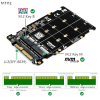Hi everyone.
I’m planning out my next server build, but need some help on the storage side.
I've been looking at the LSI 9400-16i HBA since it will do sata/sas and nvme.
But I need some help with the nvme part.
My plan is to run 4 x nvme in x2 mode so I can run 2 x nvme pr. port the controller should support it, but I can't find a cable/adapter to split the SFF-8639 to 2 x 'x2 nvme'
I have found two adapters, but i'm not sure they will work.


I want the nvme x2 design but with 8 x sas/sata disks

Hope it all make sense
I’m planning out my next server build, but need some help on the storage side.
I've been looking at the LSI 9400-16i HBA since it will do sata/sas and nvme.
But I need some help with the nvme part.
My plan is to run 4 x nvme in x2 mode so I can run 2 x nvme pr. port the controller should support it, but I can't find a cable/adapter to split the SFF-8639 to 2 x 'x2 nvme'
I have found two adapters, but i'm not sure they will work.
- AIC Shows Dual NF1 to U.2 SSD Adapter (uses the new nvme pin out)
- QDA-U2MP | Use two M.2 PCIe NVMe SSD in a U.2 PCIe NVMe SSD drive bay for PC and NAS (seams to have an pcie switch onboard)


I want the nvme x2 design but with 8 x sas/sata disks

Hope it all make sense

